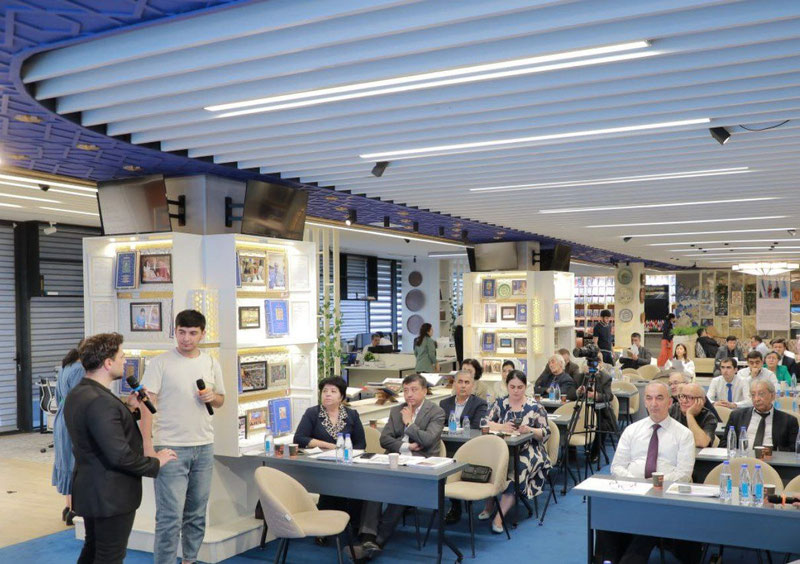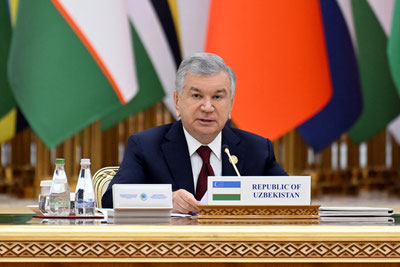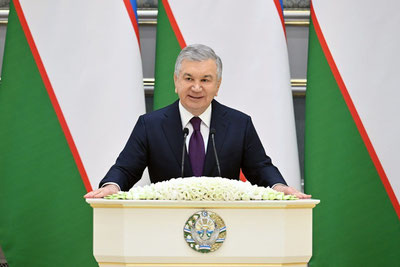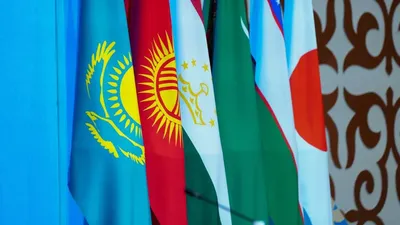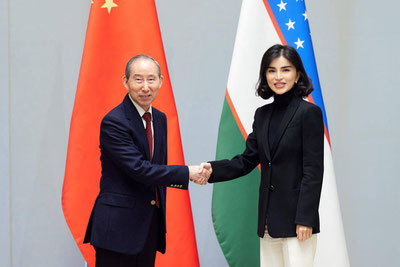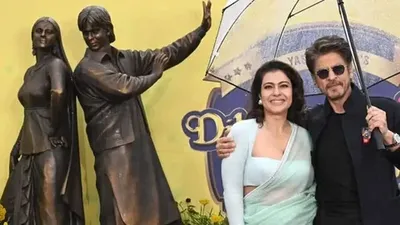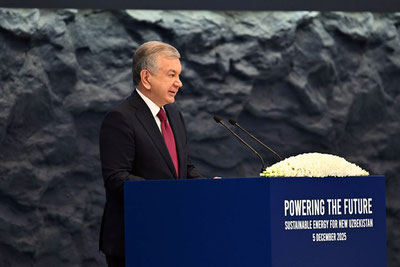A regular expanded meeting of the Scientific Council was held at the Center of Islamic Civilization in Uzbekistan, dedicated to the consideration of proposals for enriching the exposition of the center being built at the initiative of President Shavkat Mirziyoyev with meaningful content, historical artifacts, facsimile copies, models and models, as well as scientific and innovative projects of the exposition. The meeting was filled with heated debates, sharp critical reactions, and analytical opinions.
At the beginning of the meeting, the head of the Center, Chairman of the Scientific Council Firdavs Abdukhalikov, informed about the current processes, changes over the past month, and the work done.
It is noted that on January 29 of this year, during the visit of President Shavkat Mirziyoyev to the Center and familiarization with the expositions, great attention is being paid to the issues of widely demonstrating the contribution of our ancestors to world civilization, educating our youth in the spirit of loyalty to this great historical heritage, conducting various scientific discussions and debates in this unique modern place in the future, promoting relevant ideas and discoveries, creating all conditions for the development of new scientific content, enriching and improving its meaning and content, and enriching the center's exposition with meaningful content, historical artifacts and models.
Also, over the past month, about 500 local scientists have been involved in the implementation of the tasks set at the meeting of the Board of Trustees held on March 11 of this year with the participation of the Prime Minister. "Hall of the Quran, civilizations of the pre-Islamic period, the First Renaissance, the Second Renaissance and the period of the Uzbek khanates; More than 800 projects have been developed for such departments as "New Uzbekistan - New Renaissance." It was noted that more than 2,000 domestic and foreign scientists should work together on these projects. Currently, the initial stage has begun, where work is being intensively carried out on more than 400 projects in consultation with the members of the Academic Council.
To date, the 12th extended meeting of the Scientific Council has been held in 9 areas. About 50 discussions were held by about 40 small working groups across the republic in the last month alone.
In addition to scientific and innovative projects, special attention is paid to artifacts, manuscripts, and models in the 5 main exhibition halls organized within the framework of the Center's content enrichment.
Last month alone, with the participation of a number of foreign specialists, such as Frederic Bressan (France), Sergey Laptev (Japan), Irina Osmanova (Russia), it was possible to select artifacts from about ten museums of the republic. This is not enough yet. In this regard, appeals are being made to foreign museums and libraries.More than 50 museums and libraries from around the world are planned to participate in the opening of the center.
At the meeting, the head of the department of the State Hermitage Museum of Russia, Igor Malkiel, and the representative of the museum, Irina Guruleva, made a presentation on the creation of the Restoration Department in the center. During the presentation, the possibilities of bringing exhibits related to the culture and history of Uzbekistan, stored in the Museum of the State Hermitage of Russia, to the exposition of the Center, as well as the creation of a special large laboratory at the Center, were discussed.
At the meeting, it was noted that it is very important to open a separate Restoration Department in the Center, because many archaeological expeditions are being conducted in Uzbekistan, and it will be possible to restore the artifacts obtained from them in this restoration center.
It should be noted that the Hermitage has over a hundred years of experience in organizing laboratories. The State Hermitage Museum of Russia has very high restoration capabilities and is a laboratory equipped with the world's latest technologies, that is, using nanotechnology.
The Head of the Department of the State Hermitage Museum of Russia, Igor Malkiel, has been directly involved in the creation of restoration and conservation laboratories in various countries of the world during his career and is a specialist with extensive experience in organizing modern laboratories.
Also, the director and producer of the world's prestigious media project "1001 Discoveries" Ahmad Salim (Great Britain) presented his project to create a special intellectual playground for children. According to him, this playground will provide children with the opportunity to learn about the life and heritage of scholars and communicate virtually.
The media project "1001 Discoveries," directed and produced by Ahmad Salim, has been operating in more than 40 countries around the world, and this work continues to this day. Several dozen heads of state participated in the opening of many exhibitions of this media project. Also, Ahmad Salim's media project "1001 Discoveries" received special attention from the kings of Great Britain, the UAE, and the Sultan of Oman.
It should be noted that during his visits to the Center, the Head of State gave instructions to create special conditions for young people and children. This project is being implemented in accordance with these instructions. It is planned to have a variety of innovative expositions that will teach about our cultural heritage. The center has a hall with an area of 800 square meters, where the team of Ahmad Salim, director and producer of the world's prestigious company "1001 Discoveries," has begun the process of organizing a separate exposition for children. This will create convenience for those who come to the Center with children. The project allows children to get acquainted with important and necessary information in an innovative way.
"We have implemented more than 40 projects in Muslim countries. More than 500 thousand children enjoyed the expositions we prepared. This project, which we will implement in Uzbekistan, is of particular importance to us," said Salim Ahmad.
Information was also provided on plans to publish colorful books introducing the center for children and organize mobile demonstrations for children in the regions. The project will be implemented in three languages - Uzbek, English, and Russian.
During the meeting, the heads of 9 designated areas for the scientific and innovative development of the exposition informed about the innovations and additions in the departments through their presentations.
In the 1638-square-meter Quran hall, 316 rare copies of this divine book will be displayed. It will bring original and copied copies of the valuable, rare book of the Holy Quran, stored in various museums abroad. The exhibits will be displayed openly. Also included is a piece of the sacred Kaaba covering (Kiswa), a gift from the King of Saudi Arabia, presented to the President of the Republic of Uzbekistan Shavkat Mirziyoyev on February 19, 2025, by the Minister of Hajj and Umrah of Saudi Arabia, Tawfiq bin Fawzan Rabia. Foreign museums are also expected to participate in the Center's opening ceremony with ancient copies of the Holy Kaaba covers (Kiswa).
The Department of Pre-Islamic Civilizations is divided into 5 subdivisions (Ancient Khorezm, Sogdian, Bactrian, Chach, and Ancient Fergana). In total, there are 44 artifacts from the republic's museums, 37 manuscripts and originals stored in the Center's collection, and 39 artifacts from foreign museums. According to preliminary data, the total number of exhibits additionally involved in this section will exceed 200. The head of the department, Doctor of Historical Sciences, Professor Jannat Ismailova, noted that the work process in the department is currently in full swing:
Within the exposition, another exposition appears. We have developed a separate roadmap for this. Anyone who enters the department should be aware of our rich history and culture. In this regard, the working group continuously demonstrates selfless personal dedication. When we search for more, new exhibits emerge that we need to add to the section. This proves how rich our history is and how new things emerge as we delve deeper into it," said Jannat Ismailova.
The head of the "First Renaissance" group, Director of the Abu Rayhan Beruni Institute of Oriental Studies, Bakhrom Abdukhalimov, announced at the council meeting that an unusual section is expected in the exposition. It is noted that the department will be in the form of a small building inside the building.
"If we open the center properly and hand it over to our people, we will have fulfilled our responsible task. We scientists are racking our brains day and night over this. In total, our department plans to implement more than 220 artifacts and more than 126 projects. We have high hopes for the projects. The department's format is also unusual, and visitors can enjoy our fascinating history. The department will have the opportunity to regularly post discoveries, innovations, and new findings. "A logical exchange of exhibits will also be established," said B. Abduhalimov.
Khurshid Fayziev, head of the "Second Renaissance" group and director of the State Museum of Timurid History, also made a presentation on the projects. He noted that the exposition of the "Second Renaissance" section is divided into 5 periods by individuals for 148 projects. Among them are the sectors of Amir Temur, Shahrukh Mirzo, Mirzo Ulugbek, Sultan Husayn Mirzo, Alisher Navoi, and Zahiriddin Muhammad Babur.
Of these, 304 are Timurid artifacts stored abroad, and the total number of artifacts in Uzbekistan is 106, which will be included as a base in the future.
Members of the Council on this section made proposals for partial changes to the arch at the entrance of the building. At the meeting, an analysis of works related to painting at the center was also conducted. A number of proposals and comments were made by the members of the Council. According to People's Artist of Uzbekistan, Academician Bakhodir Jalolov, the shape and arrangement of each exhibit in the exposition should be elegant and beautiful.
I get news for myself at every meeting of the council. Each of our meetings on the issue of establishing the center is organized with great responsibility. I wanted to reflect such heated discussions among scientists in creating images for the exposition. Where scholars gather, there will certainly be debate and discussion. This was warmly received by international experts and partners. Various opinions and attitudes were expressed by local scientists. I try to take these into account in my confidences. They are expressing well-founded opinions," said Bakhodir Jalolov.
The image of historical figures has always been at the center of discussions and debates. This issue was also discussed at previous meetings of the Council for a long time. Academician of the Academy of Sciences of Uzbekistan, art critic Akbar Hakimov highly appreciated the works of Bakhodir Jalolov. He emphasized that his works contain historical truth and a product of thoughtful creativity.
The historian writes about how the event happened, and the artist creatively approaches it, asking what the event could have been. Therefore, let's leave the creator free in creating images of historical figures, allowing them to create based on their precise scientific and intellectual understanding. It should not be denied. True, he needs to take this seriously, but you can't ruin an entire work with just one word. "One must believe in the artist's potential, apply it with ideas," said Akbar Hakimov.
At the council meeting, it was noted that rare exhibits will be collected in small quantities. Excursions were organized abroad, during which more than 300 exhibits related to the history and culture of our country were discovered. Of course, this is not enough for a large Center. A prestigious UNESCO event is planned to be held in our country in November. More than 400 exhibits are planned to be presented to the Center. It was reported that a working group headed by the Minister of Culture of the Republic of Uzbekistan, Ozodbek Nazarbekov, is planning to organize field expeditions and collect exhibits from home museums and cultural venues in the regions for the Center. It was also announced that the exhibits will be displayed to the public openly, not secretly. The exhibits are kept in an open, bright, and modern open building, not in basements or closed museums. Board members should submit ready-made content to the responsible parties in the form of albums and proceed with the processes.
